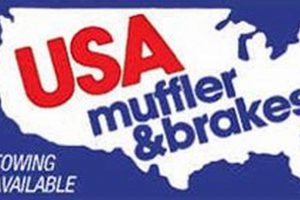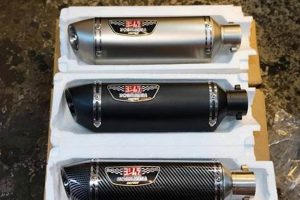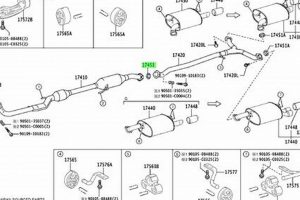A device employed to reduce the noise generated by exhausting compressed air from pneumatic systems is a crucial component for workplace safety and environmental consideration. These components are typically constructed using porous materials like sintered bronze or plastic and are designed to diffuse the escaping air, thus lowering the decibel level. For instance, in a manufacturing plant utilizing automated machinery powered by compressed air, the rapid release of air from cylinders and valves can create significant noise pollution.
The adoption of these noise reduction elements offers several benefits. Primarily, it contributes to a safer and more comfortable working environment by mitigating noise-induced hearing loss and reducing employee stress. Furthermore, compliance with occupational safety regulations often necessitates the implementation of noise control measures. Historically, the use of such components has evolved from simple baffling techniques to sophisticated designs that minimize backpressure while maximizing noise reduction effectiveness.
The subsequent sections will delve into specific types, performance characteristics, and selection criteria for these essential components, providing a detailed understanding of how to optimize their application within various pneumatic systems.
Essential Considerations for Implementing Air Exhaust Silencers
Optimal performance of compressed air systems necessitates careful attention to noise reduction. The following tips offer guidance on selecting and utilizing these components effectively.
Tip 1: Select the Appropriate Size and Thread Type: Ensure compatibility with the exhaust port of the pneumatic valve or cylinder. Incompatible threading can lead to leaks and reduced performance.
Tip 2: Consider the Flow Rate: Choose a unit rated for the anticipated flow rate of the pneumatic system. Undersized components will create backpressure, negatively impacting system efficiency.
Tip 3: Evaluate the Material Compatibility: Select a material resistant to the operating environment. For example, stainless steel construction is preferable in corrosive environments.
Tip 4: Prioritize Noise Reduction Level: Determine the required noise reduction level based on workplace safety regulations and desired sound levels. Data sheets provide information on decibel reduction capabilities.
Tip 5: Monitor for Clogging: Regularly inspect for debris accumulation within the porous material. Clogged units reduce airflow and increase backpressure, diminishing system performance. Implement a preventative maintenance schedule for cleaning or replacement.
Tip 6: Optimize Placement: Position these units strategically to minimize noise transmission. Consider enclosing noisy components or directing exhaust away from work areas.
Tip 7: Evaluate Backpressure: Excessive backpressure compromises efficiency. Where high exhaust volumes are present, consider designs that minimize backpressure for optimum pneumatic system performance.
By adhering to these guidelines, the selection and implementation of these noise reduction elements can significantly improve workplace safety, reduce noise pollution, and optimize pneumatic system performance.
The subsequent sections will cover advanced applications and troubleshooting techniques related to compressed air noise reduction.
1. Noise Reduction Efficiency
Noise Reduction Efficiency is a critical performance parameter when evaluating pneumatic mufflers. It quantifies the device’s ability to attenuate the sound pressure level generated by exhausting compressed air. The effectiveness of a muffler directly impacts workplace safety, environmental compliance, and overall operational comfort.
- Decibel Attenuation
Decibel attenuation refers to the reduction in sound pressure level, typically measured in dBA, achieved by the muffler. A higher decibel attenuation indicates greater noise reduction. For instance, a muffler with a 30 dBA reduction rating will significantly decrease the noise level compared to one with a 10 dBA rating. This facet directly influences the selection of a muffler for specific applications with varying noise exposure limits.
- Frequency Spectrum Attenuation
Mufflers often exhibit varying attenuation characteristics across different frequency ranges. Some designs excel at reducing high-frequency noise, while others are more effective at attenuating lower frequencies. Understanding the frequency spectrum of the noise source is crucial for selecting a muffler that provides optimal noise reduction across the relevant frequencies. For example, a muffler designed for low-frequency attenuation might be preferred in applications where the dominant noise component is low-frequency rumble.
- Backpressure Considerations
Noise reduction efficiency must be balanced against the backpressure introduced by the muffler. Excessive backpressure can impede the performance of the pneumatic system, leading to reduced speed, increased energy consumption, and potential damage to components. A highly efficient muffler that generates significant backpressure may not be suitable for applications requiring high flow rates and minimal pressure drop. Muffler designs that prioritize noise reduction while minimizing backpressure are generally preferred.
- Material and Design Factors
The materials used in the construction of a muffler, as well as its internal design, significantly influence its noise reduction efficiency. Porous materials, such as sintered bronze or plastic, effectively dissipate sound energy through friction and diffusion. Internal baffle designs and expansion chambers can further enhance noise reduction by redirecting and attenuating sound waves. The choice of materials also impacts the muffler’s durability and resistance to environmental factors, such as moisture, chemicals, and temperature extremes.
In summary, Noise Reduction Efficiency is a multifaceted characteristic of pneumatic mufflers, encompassing decibel attenuation, frequency spectrum performance, backpressure considerations, and material properties. Careful evaluation of these facets is essential for selecting a muffler that effectively reduces noise pollution without compromising the performance of the pneumatic system. The specific requirements of the application, including noise exposure limits, flow rate requirements, and environmental conditions, should guide the selection process.
2. Backpressure Minimization
Backpressure minimization is a paramount design consideration in the development and application of pneumatic mufflers. The fundamental purpose of a muffler is to reduce noise generated by exhausting compressed air; however, this noise reduction should not significantly impede the functionality of the pneumatic system it serves. Introducing excessive backpressure can negatively affect system performance, leading to reduced actuator speed, increased cycle times, and elevated energy consumption. The ideal muffler design achieves a balance between effective noise attenuation and minimal restriction of airflow.
For example, in high-speed automated assembly lines, pneumatic cylinders are frequently employed for rapid and repetitive tasks. If a muffler with high backpressure is installed on the exhaust port of these cylinders, the cylinder’s retraction speed may be substantially reduced, thereby decreasing the overall throughput of the assembly line. Conversely, a muffler designed with large flow passages and a low-restriction porous element will minimize backpressure, allowing the cylinder to operate at its designed speed while still effectively suppressing exhaust noise. Material selection also plays a key role; sintered bronze or certain engineered plastics can provide the necessary porosity for noise reduction while maintaining low flow resistance. The geometry of the muffler, including the size and shape of the expansion chamber and the configuration of internal baffles, further contributes to minimizing pressure drop across the device.
In conclusion, backpressure minimization is inextricably linked to the overall effectiveness of a pneumatic muffler. Careful engineering and material selection are essential to ensure that noise reduction is achieved without compromising the performance of the pneumatic system. Understanding the trade-offs between noise attenuation and pressure drop is crucial for selecting the appropriate muffler for a given application and optimizing the efficiency of pneumatic systems in various industrial settings. The pursuit of this balance remains a central challenge in pneumatic system design.
3. Thread Size Compatibility
Thread size compatibility is a critical factor in the proper functioning and effectiveness of a pneumatic muffler. The connection between a pneumatic muffler and the pneumatic system it serves is established through a threaded connection. Incompatibility in thread size renders the muffler unusable, negating its intended purpose of noise reduction. Correct thread size ensures a secure, leak-proof connection, allowing the muffler to effectively diffuse and attenuate the noise generated by exhausting compressed air. Conversely, an incorrect thread size will result in leaks, diminished noise reduction, and potential damage to the pneumatic system’s components. For example, attempting to install a muffler with a 1/4″ NPT thread onto a valve with a 1/8″ NPT port will inevitably lead to a failed connection and compromised system performance. The practical significance of understanding this relationship lies in the prevention of downtime, wasted resources, and potential safety hazards in industrial settings.
Further analysis reveals that thread size compatibility extends beyond simply matching the physical dimensions of the threads. Thread standards, such as NPT (National Pipe Thread) and BSP (British Standard Pipe), also play a crucial role. Using a muffler with an incompatible thread standard can damage both the muffler and the pneumatic system’s components, even if the physical thread size appears to be similar. For instance, attempting to force an NPT fitting into a BSP port will typically result in damaged threads and a compromised seal. Practical applications in manufacturing plants necessitate strict adherence to thread size and standard specifications during the installation and maintenance of pneumatic systems. Proper training and the use of standardized tools are essential to ensure correct thread size compatibility and prevent installation errors.
In conclusion, thread size compatibility is not merely a mechanical detail but an essential requirement for the successful integration of pneumatic mufflers into compressed air systems. Ensuring correct thread size and adherence to relevant thread standards are fundamental to achieving optimal noise reduction, preventing system malfunctions, and maintaining a safe working environment. Challenges in achieving compatibility may arise from variations in thread standards across different regions or manufacturers. However, these challenges can be mitigated through careful selection, standardized practices, and thorough inspection of components prior to installation, reinforcing the crucial link between thread size compatibility and effective noise control in pneumatic systems.
4. Material Durability
Material durability is a defining attribute that governs the operational lifespan and performance consistency of a noise-reduction device. The selection of appropriate materials ensures that these components can withstand the rigors of industrial environments, maintaining their noise-dampening capabilities over extended periods.
- Resistance to Corrosion
In many industrial settings, exposure to corrosive substances is inevitable. Materials utilized in the construction of these units must exhibit resistance to chemical degradation. Stainless steel and certain engineered polymers are commonly employed due to their ability to withstand exposure to moisture, oils, and other corrosive agents. Failure to account for corrosion resistance can lead to premature failure of the muffler, resulting in increased noise levels and potential system malfunctions.
- Mechanical Strength and Impact Resistance
Industrial environments often present the risk of physical impacts and mechanical stresses. Muffler bodies and internal components must possess sufficient mechanical strength to withstand these forces. Materials like brass, aluminum, and reinforced plastics are selected for their ability to absorb impacts and resist deformation. The structural integrity of the muffler directly affects its ability to maintain its noise-reduction capabilities. Damage to the muffler body or internal components can compromise its acoustic performance and lead to premature failure.
- Temperature Stability
Pneumatic systems often operate across a wide range of temperatures. The materials used in these units must maintain their structural integrity and acoustic properties within the specified temperature range. High-temperature applications may require the use of specialized materials like high-temperature plastics or stainless steel alloys. Failure to account for temperature effects can lead to material degradation, dimensional changes, and a reduction in noise-reduction performance.
- Resistance to Abrasive Particles
In certain environments, pneumatic systems may be exposed to abrasive particles, such as dust, dirt, and metal filings. Muffler materials must exhibit resistance to abrasion to prevent erosion and clogging of the porous elements responsible for noise reduction. Sintered bronze and certain types of filtration media are chosen for their ability to withstand abrasive wear. The accumulation of abrasive particles within the muffler can reduce its noise-reduction efficiency and increase backpressure.
These facets of material durability collectively determine the longevity and reliability of a noise reduction device in demanding industrial applications. Selection of appropriate materials, coupled with proper maintenance practices, ensures that these components provide consistent noise reduction performance over their intended lifespan, contributing to a safer and more productive working environment.
5. Flow Rate Capacity
Flow rate capacity represents a critical performance parameter for any pneumatic muffler. This metric defines the volume of compressed air that the muffler can effectively process within a given time frame, typically expressed in standard cubic feet per minute (SCFM) or liters per minute (LPM). A muffler’s ability to handle the exhaust flow rate of a pneumatic system directly impacts its operational efficiency and noise reduction effectiveness. Insufficient flow rate capacity causes increased backpressure, which degrades system performance by reducing actuator speed and increasing cycle times. In contrast, a properly sized muffler allows for uninhibited exhaust flow while effectively dampening noise. For example, consider a pneumatic cylinder used in a high-speed packaging machine. If the muffler installed on the cylinder’s exhaust port has an inadequate flow rate capacity, the cylinder’s retraction speed will be reduced, slowing down the entire packaging process and potentially causing production bottlenecks.
The design of a pneumatic muffler directly influences its flow rate capacity. Mufflers with larger internal volumes, optimized flow paths, and porous elements constructed from materials with high permeability exhibit superior flow characteristics. Sintered bronze, a common material used in muffler construction, offers a balance between noise reduction and airflow. However, its flow rate capacity can be further optimized through careful control of pore size and distribution during the sintering process. Similarly, muffler designs that incorporate expansion chambers and baffles can enhance noise reduction without unduly restricting airflow. In practical applications, selecting a muffler with a flow rate capacity that matches or slightly exceeds the system’s maximum exhaust flow is essential to ensure optimal performance. Manufacturers typically provide flow rate curves for their muffler products, enabling engineers to make informed selection decisions based on specific system requirements. These flow rate curves illustrate the relationship between flow rate and backpressure, allowing users to assess the trade-offs between noise reduction and system performance.
In conclusion, flow rate capacity is not merely a specification; it is an integral performance attribute that dictates the effectiveness and efficiency of a pneumatic muffler. A mismatch between muffler flow rate capacity and system requirements results in performance degradation and potential system malfunctions. Careful consideration of flow rate requirements, coupled with informed muffler selection based on manufacturer-provided data, is crucial for optimizing pneumatic system performance and achieving effective noise reduction. Challenges in accurately assessing flow rate requirements may arise from complex system dynamics or variable operating conditions. However, these challenges can be addressed through thorough system analysis and the use of adjustable mufflers that allow for fine-tuning of flow rate and backpressure characteristics, reinforcing the inextricable link between flow rate capacity and pneumatic system performance.
6. Maintenance Requirements
The operational effectiveness and longevity of a pneumatic muffler are directly correlated with adherence to established maintenance protocols. Neglecting maintenance results in diminished noise reduction capabilities, increased backpressure, and, ultimately, premature failure of the component. The accumulation of contaminants, such as dust, oil, and moisture, within the porous element of the muffler impedes airflow and reduces its capacity to effectively dissipate sound waves. For example, in a woodworking facility, sawdust particles can rapidly clog a pneumatic muffler, leading to increased noise levels and reduced efficiency of the pneumatic tools it serves. This degradation in performance necessitates regular inspection and cleaning or replacement of the muffler to maintain optimal system operation and comply with noise regulations. Therefore, establishing a proactive maintenance schedule is indispensable for preserving the functional integrity of the device.
Further analysis reveals that the type of maintenance required is contingent upon the design and materials of the muffler, as well as the specific operating environment. Mufflers constructed from sintered bronze may require ultrasonic cleaning or backflushing with compressed air to remove embedded contaminants. Disposable mufflers, often fabricated from plastic or paper-based materials, are typically replaced when their performance deteriorates beyond acceptable limits. In applications involving high levels of contamination, inline filtration systems can be implemented to prevent particles from reaching the muffler, thereby extending its service life. Practical applications within manufacturing plants demonstrate that incorporating muffler maintenance into routine equipment servicing schedules significantly reduces downtime and overall operating costs. Failure to address maintenance needs proactively necessitates more frequent replacements and increases the risk of system malfunctions.
In conclusion, maintenance is not a peripheral concern but an integral component of pneumatic muffler operation. It dictates the sustained effectiveness of the device and impacts the overall performance and reliability of the pneumatic system. Challenges in implementing effective maintenance programs may arise from inadequate training, limited access to replacement parts, or a lack of awareness regarding the importance of preventative measures. However, these challenges can be mitigated through comprehensive training initiatives, readily available spare parts inventories, and a commitment to incorporating maintenance protocols into standard operating procedures, reinforcing the critical role of maintenance in ensuring optimal muffler performance and long-term system efficiency.
7. Environmental Suitability
The operational effectiveness and long-term viability of a pneumatic muffler are intrinsically linked to its environmental suitability. This encompasses the device’s capacity to withstand the specific conditions of its operating environment without experiencing degradation in performance or structural integrity. Environmental suitability dictates the material selection, design features, and maintenance requirements of a pneumatic muffler, impacting its ability to effectively reduce noise pollution while minimizing its own environmental footprint. For instance, a muffler deployed in a food processing plant must be constructed from materials that are compliant with food safety regulations, preventing contamination of the products being manufactured. Similarly, a muffler situated in a corrosive environment, such as a chemical processing facility, must be fabricated from materials resistant to chemical attack, ensuring its longevity and consistent performance. Inadequate attention to environmental suitability results in premature failure, increased noise pollution, and potential environmental hazards.
Further consideration reveals that environmental suitability extends beyond simply resisting physical or chemical degradation. It also encompasses the muffler’s contribution to the overall environmental impact of the pneumatic system. The energy efficiency of the muffler, its recyclability, and the use of environmentally friendly materials in its construction are all relevant factors. For example, a muffler that introduces excessive backpressure increases the energy consumption of the pneumatic system, indirectly contributing to greenhouse gas emissions. Conversely, a well-designed muffler constructed from recycled materials and offering minimal backpressure promotes energy efficiency and reduces its environmental impact. In practical applications, manufacturers are increasingly focused on developing mufflers that meet stringent environmental standards, such as RoHS compliance and REACH regulations, demonstrating a commitment to sustainable manufacturing practices. Incorporating life cycle assessment methodologies into the design process allows for a comprehensive evaluation of the muffler’s environmental impact, from raw material extraction to end-of-life disposal.
In conclusion, environmental suitability is not merely a supplementary consideration but a core attribute that defines the performance and sustainability of a pneumatic muffler. It necessitates a holistic approach that encompasses material selection, design optimization, and adherence to environmental regulations. Challenges in achieving environmental suitability may arise from the complexity of industrial environments or the lack of readily available environmentally friendly materials. However, these challenges can be addressed through ongoing research and development, collaboration between manufacturers and regulatory agencies, and a commitment to integrating environmental considerations into all aspects of pneumatic system design, reinforcing the critical link between environmental suitability and responsible engineering practices.
Frequently Asked Questions
The following questions address common inquiries and misconceptions concerning pneumatic mufflers, their function, and proper application.
Question 1: What is the primary function of a device?
The primary function is to reduce the sound pressure level generated by exhausting compressed air from pneumatic systems, thereby contributing to a safer and more comfortable working environment.
Question 2: What factors determine the selection of a unit for a specific application?
Selection criteria include the required noise reduction level, the system’s flow rate, thread size compatibility, the operating environment (e.g., corrosive, high-temperature), and the acceptable level of backpressure.
Question 3: How does backpressure impact the performance of a pneumatic system?
Excessive backpressure reduces actuator speed, increases cycle times, elevates energy consumption, and potentially damages system components.
Question 4: What are the typical materials used in the construction of a noise reduction device, and what are their respective advantages?
Common materials include sintered bronze, stainless steel, and engineered plastics. Sintered bronze offers a balance of noise reduction and airflow. Stainless steel provides corrosion resistance. Engineered plastics offer lightweight and cost-effective solutions.
Question 5: How often should units be maintained or replaced?
Maintenance frequency depends on the operating environment and the level of contamination. Regular inspection is essential. Cleaning or replacement should occur when noise reduction performance diminishes or backpressure increases significantly.
Question 6: Are there any regulations governing the use of noise-reduction devices in industrial settings?
Occupational Safety and Health Administration (OSHA) and other regulatory bodies may establish noise exposure limits. The use of units is often necessary to comply with these regulations and prevent noise-induced hearing loss.
In summary, appropriate selection, installation, and maintenance of these components are crucial for achieving effective noise reduction, optimizing system performance, and ensuring regulatory compliance.
The subsequent section will explore advanced applications and troubleshooting techniques related to noise-reduction elements in pneumatic systems.
Conclusion
This article has provided a comprehensive overview of the “pneumatic muffler,” encompassing its definition, operational principles, selection criteria, maintenance requirements, and environmental considerations. The importance of these devices in mitigating noise pollution in industrial environments has been emphasized, alongside the need for balancing noise reduction with system performance.
Effective utilization of the “pneumatic muffler” is not merely a matter of compliance, but a commitment to worker safety, environmental responsibility, and optimized system operation. Continued research and development in this field are essential to meet increasingly stringent noise regulations and enhance the efficiency of pneumatic systems worldwide.







